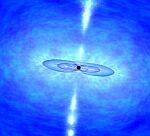Gamma-ray burst marks death of giant star
Posted: Thu, Mar 20, 2003, 10:31 AM ET (1531 GMT)
 Astronomers who observed a gamma-ray burst (GRB) from its early stages believe that the burst marks the collapse of a giant star into a black hole. A GRB was spotted by NASA's High-Energy Transient Explorer (HETE) spacecraft on October 4, 2002; the spacecraft alerted astronomers, who trained telescopes on the location of the burst within several minutes. Those observations showed the optical afterglow of the burst was powered by energy from the burst for at least a half-hour, and the energy of the GRB overall was several times greater than previously thought. This led astronomers to conclude that the burst originated from the death throes of a star 15 times as massive as the Sun, a method known as the collapsar model. They believe the core of the massive star may have collapsed into a black hole. The findings have been published in the latest issue of the journal Nature.
Astronomers who observed a gamma-ray burst (GRB) from its early stages believe that the burst marks the collapse of a giant star into a black hole. A GRB was spotted by NASA's High-Energy Transient Explorer (HETE) spacecraft on October 4, 2002; the spacecraft alerted astronomers, who trained telescopes on the location of the burst within several minutes. Those observations showed the optical afterglow of the burst was powered by energy from the burst for at least a half-hour, and the energy of the GRB overall was several times greater than previously thought. This led astronomers to conclude that the burst originated from the death throes of a star 15 times as massive as the Sun, a method known as the collapsar model. They believe the core of the massive star may have collapsed into a black hole. The findings have been published in the latest issue of the journal Nature.
 Astronomers who observed a gamma-ray burst (GRB) from its early stages believe that the burst marks the collapse of a giant star into a black hole. A GRB was spotted by NASA's High-Energy Transient Explorer (HETE) spacecraft on October 4, 2002; the spacecraft alerted astronomers, who trained telescopes on the location of the burst within several minutes. Those observations showed the optical afterglow of the burst was powered by energy from the burst for at least a half-hour, and the energy of the GRB overall was several times greater than previously thought. This led astronomers to conclude that the burst originated from the death throes of a star 15 times as massive as the Sun, a method known as the collapsar model. They believe the core of the massive star may have collapsed into a black hole. The findings have been published in the latest issue of the journal Nature.
Astronomers who observed a gamma-ray burst (GRB) from its early stages believe that the burst marks the collapse of a giant star into a black hole. A GRB was spotted by NASA's High-Energy Transient Explorer (HETE) spacecraft on October 4, 2002; the spacecraft alerted astronomers, who trained telescopes on the location of the burst within several minutes. Those observations showed the optical afterglow of the burst was powered by energy from the burst for at least a half-hour, and the energy of the GRB overall was several times greater than previously thought. This led astronomers to conclude that the burst originated from the death throes of a star 15 times as massive as the Sun, a method known as the collapsar model. They believe the core of the massive star may have collapsed into a black hole. The findings have been published in the latest issue of the journal Nature.
Related Links:
| <<previous article | next article>> |
|
news in brief
|
|
Roscosmos replaces cosmonaut on next Crew Dragon mission to ISS
Posted: Sat, Dec 6 9:45 AM ET (1445 GMT) |
|
news links
|
|
Tuesday, December 23
Innospace's Hanbit-Nano falls to ground after liftoff in Brazil
Yonhap News — 7:45 am ET (1245 GMT) Rocket Launched by Korea’s Innospace Crashes; Shares Tumble
Bloomberg News — 7:45 am ET (1245 GMT) Korea’s first commercial space launch attempt fails as Hanbit-Nano rocket appears to explode after liftoff
JoongAng Daily — 7:44 am ET (1244 GMT) Korea’s 1st commercial space vehicle launch fails
Korea Times — 7:43 am ET (1243 GMT) Innospace’s Hanbit-Nano Rocket Fails In Inaugural Launch
Aviation Week — 7:43 am ET (1243 GMT) |